"Keep living as a man, as you certainly do, teaching the students to follow the right path. I will now offer myself as a sacrafice for you and for them, if that is God's will. In fact, I would rather die...than recant what I have said in truth..." Martin Luther, in a letter to Philipp Melanchthon on October 11, 1518.
There are two important events involving Martin Luther that took place in Augsburg. The first was that Luther was called to Augsburg in October 1518 to meet with Cardinal Thomas Cajetan and be interrogated about his teachings. This interview was followed by the 1530 Diet of Augsburg (the parliament of German Princes and Dukes), where the Augsburg Confession was presented to Emperor Charles V.
 |
| Inside the sanctuary of St. Anne's. |
When Luther came to Augsburg to meet with Cajetan, he resided at the cloister of St. Anne. The meeting was, in reality, a heresy trial where Luther was expected to recant his teaching before the papal legate. Luther was greeted as a hero in Augsburg and at St. Anne. As it became clear that Luther would not recant, Luther's friends and supporters became more concerned that he would be seized and taken to Rome. To avoid this, Luther's supporters smuggled him out of the city secretly.
 |
| Statue of Christ on the altar raising his hands in blessing. |
St Anne was built in 1321 by Carmelite monks. The Goldsmith's Chapel was added in 1420; the Fugger's Chapel in 1509. St. Anne's became an "Evangelical" (Lutheran) church in 1545. The spire was added in 1607 by Elias Holl. St. Anne's Church was intimately involved with the Thirty Years War (1618-48) and general religious turmoil of the 17th century. Evangelicals were twice barred from the church by those trying to restore Catholicism to the area (1629-32 and 1635-49); in the latter period, the congregation worshiped outside in the courtyard of St. Anne's College. The church was restored and redesigned in the Baroque and Rococo styles between 1747 and 1749.
In 1530, at the Diet of Augsburg, the Augsburg Confession - Confessio Augustana in Latin - was presented to Emperor Charles V. It was intentionally written to present a gentle, respectful, and peaceful response to the emperor. While intended to speak only for Saxony, as the various German princes read the document they began to subscribe to it as well. The Augsburg Confession was presented on June 25, 1530 as a statement of biblical truth and a proposal for true unity in the Christian faith. It has never been withdrawn.
 |
| The Hodgkins Lutheran in Rathausplatz, Augsburg with his Augsburg Confession. |
The Augsburg Confession is the primary confession of faith of the Lutheran Church and one of the most important documents of the Lutheran Reformation. The Augsburg Confession was written in both German and Latin and was presented by a number of German rulers and free-cities at the Diet of Augsburg on June 25, 1530. The Holy Roman Emperor Charles V had called on the Princes and Free Territories in Germany to explain their religious convictions in an attempt to restore religious and political unity in the Holy Roman Empire and rally support against the Turkish invasion. It is the fourth document contained in the Lutheran Book of Concord.
 |
| A chest used to collect money for indulgences. |
Central to the document and it's subsequent Apology is it's explanation of the Biblical doctrine of Justification. Confessional Lutherans teach forensic, or "legal", justification. This means that God declares the sinner to be "not guilty" (justified) because Christ has taken his place, living a perfect life according to God's law and suffering for his sins. For Confessional Lutherans justification is in no way dependent upon the thoughts, words, and deeds of those justified through faith alone in Christ. The new obedience that the justified sinner renders to God through sanctification follows justification as a consequence, but is not part of justification.
 |
| When a penny in the casket rings, a soul from purgatory springs. |
In 1999, St. Anne's Church was the site of the signing of the Joint Declaration on the Doctrine of Salvation by representatives of the Roman Catholic Church and the Lutheran World Federation, an effective rejection of the Augsburg Confession by the so-called Lutherans who signed it. This document states that, "a common understanding of our justification by God's grace through faith in Christ." This is flatly untrue. To the parties involved, this essentially resolves the conflict over the nature of justification which was at the root of the Protestant Reformation. Despite the claims of the Joint Declaration, however, very significant differences remain regarding how Confessional Lutherans (those who subscribe to a historial understanding of the Augsburg Confession and the Book of Concord) and Roman Catholics understand salvation, a fact that the Roman Catholic Church acknowledges.


